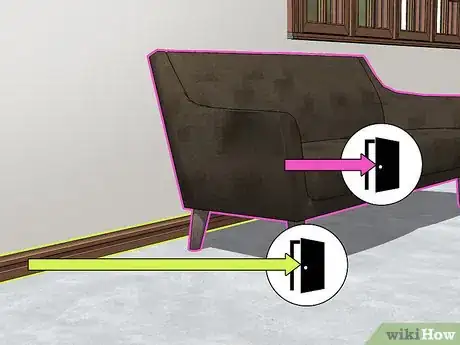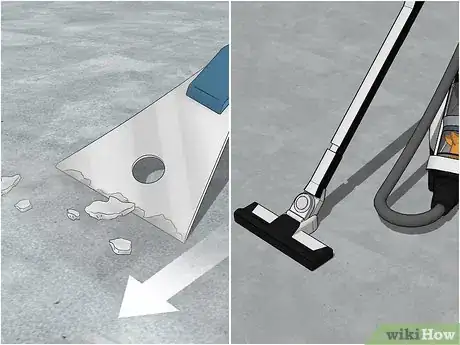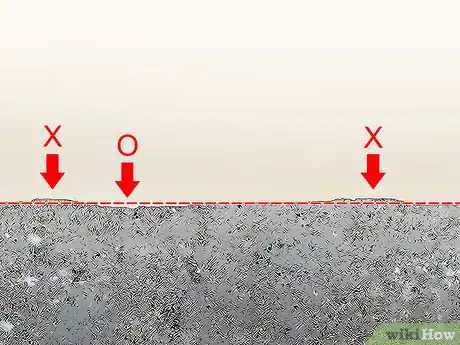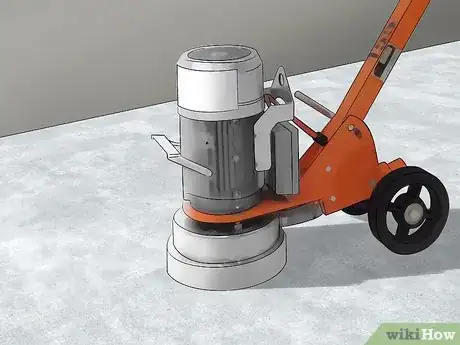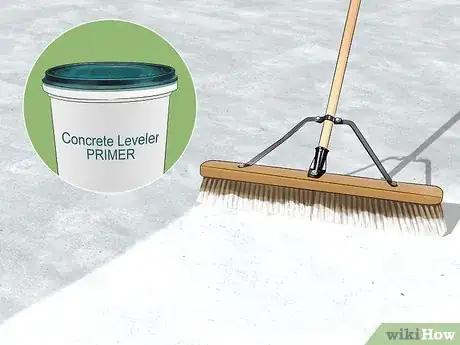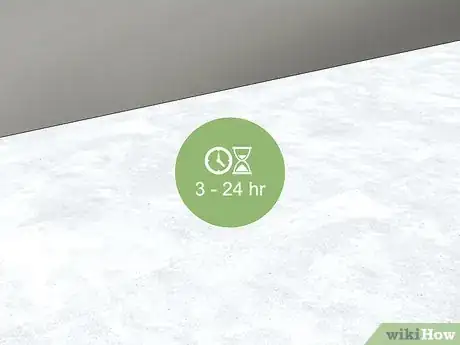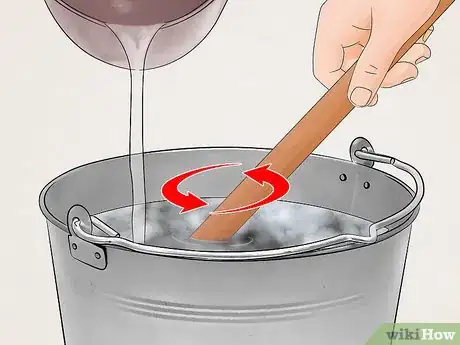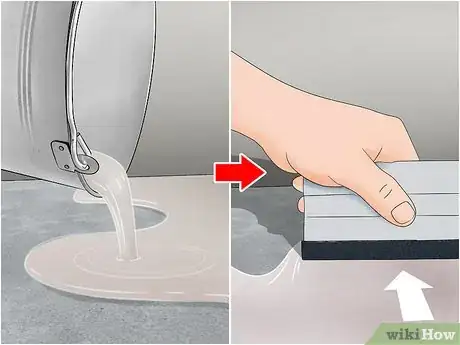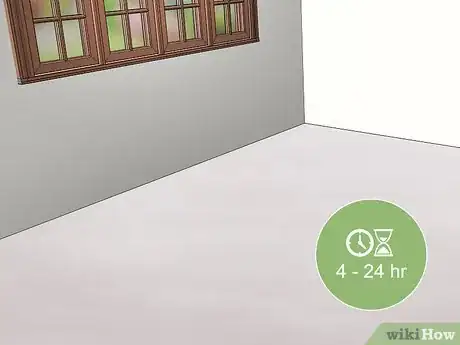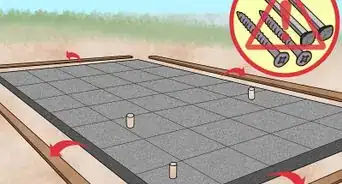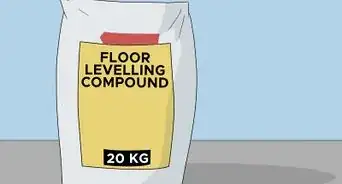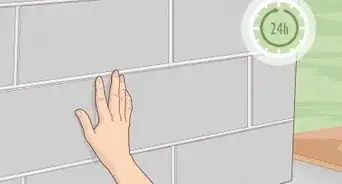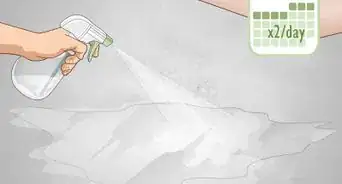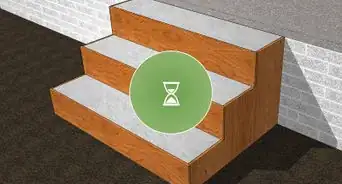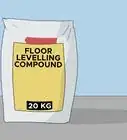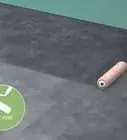This article was co-authored by Gerber Ortiz-Vega. Gerber Ortiz-Vega is a Masonry Specialist and the Founder of GO Masonry LLC, a masonry company based in Northern Virginia. Gerber specializes in providing brick and stone laying services, concrete installations, and masonry repairs. Gerber has over four years of experience running GO Masonry and over ten years of general masonry work experience. He earned a BA in Marketing from the University of Mary Washington in 2017.
This article has been viewed 307,282 times.
Over time, concrete floors can settle unevenly or become uneven due to cracking and moisture. Whether you want to refinish an uneven basement floor, or replace or add new flooring on top of an existing concrete floor somewhere in your home, you most likely will need to level the concrete floor. With the right preparation, equipment, and self-leveling concrete mix, you will be able to do this job yourself in 1-2 days!
Steps
Cleaning the Concrete Floor
-
1Remove all of the furniture, appliances, and baseboards from the room. Take everything out of the room so that the floor is completely clear. Remove any baseboards as well because the height of the floor will raise after you level it.[1]
- Use a metal putty knife or scraper to gently pry baseboards off the walls. Start at one end of the baseboard and move along the entire length of the piece until the whole board is loose enough to pull off the wall.
-
2Scrape up any debris from the floor and vacuum the entire room. Use a metal scraper to remove any loose debris like old linoleum, tile, or chipping concrete. Sweep it up and dispose of it, then vacuum the floor to get rid of all dirt and dust.[2]
- A shop-vac is the best type of vacuum for this job. You might end up destroying your regular vacuum if you suck up too much cement and heavy debris. You can most likely rent a shop-vac at your local home improvement center by the day.
- It's important that the floor receiving the cement (the stumps) is in good shape before you even start pouring the cement.[3]
Advertisement -
3Fill in any large cracks or holes with concrete filler and sealer. Stick the nozzle of the concrete filler bottle into the crack and squeeze the filler out until the crack is sealed, or use a trowel to press the filler into the crack. Let the filler and sealer dry before you continue with the prep work.[4]
- You want to fill in any cracks before you prime the floor and pour leveler, or you will end up using much more leveler as it flows into the cracks.
-
4Use a piece of chalk to mark all obvious high and low spots on the floor. Mark any concrete bumps that are raised above the rest of the floor with an "X", and any dips that are lower than the floor with an "O". Sweep over the floor with a carpenter’s level to reveal any depressions you may have missed.[5]
- Work in small sections with the carpenter’s level to ensure you sweep over the whole room. Lay the level flat on the floor and look at the bubble in the middle to see if the floor is level in each section.
-
5Use a concrete grinder to grind down any particularly high spots. Wear eye protection and a face mask, start the grinder’s engine, lay the disc flat against the spot you want to grind down, and move it in a side to side or front to back motion until you grind the bump down to floor level. Grind down all the spots you marked with an “X” with the chalk, then vacuum up the dust with a shop-vac.[6]
- You can rent a concrete grinder for the job at most home center stores. Remember that you will have to get the grinder up and down the stairs if you are working in a basement.
-
6Apply concrete leveler primer to the floor with a soft-bristle push broom. Spread it over the entire surface of the floor with the push broom, and apply downward pressure to work it into the pores of the concrete. Make sure to smooth out any puddles of primer to end up with an even coat.[7]
- You can also fill a paint tray with the primer and use a long-handled paint roller to spread it over the floor.[8]
- 1 gallon (3.78 l) of primer can cover up to 400 square feet (37 square meters) of floor space.
-
7Allow the concrete leveler primer to dry from 3-24 hours. Let it dry until it has a tacky finish. You will have to re-apply the primer if you let it dry longer than 24 hours.[9]
Pouring the Concrete Leveler
-
1Mix the concrete leveler compound in a bucket with a drill and mixing paddle. Fill a 5 gallon (18.9 l) bucket with a bag of concrete leveler and the amount of water that the instructions on the bag call for. Mix it thoroughly with a drill-mounted mixing paddle until it is an even consistency.[10]
- Don’t mix more than one bag of concrete leveler at a time because you only have about 15-30 minutes during which it is pourable and spreadable.
- Work with a partner if you can, so that one person can mix the next batch of leveler while the other pours and spreads it out.[11]
- If you're using self-leveling cement, its viscosity will be quite low, about that of a milkshake. Therefore, make sure that all the sides are secured so the concrete won't spill over to an area where you don't want it to be.[12]
-
2Dump the mix onto the floor and spread it out with a long-handled squeegee. Push and pull the concrete leveler over the floor with the squeegee to coat it evenly. Make sure to get all the way into the corners and along the edges of the room.[13]
- Concrete leveler compound is designed to spread out evenly with the force of gravity. Use the squeegee to help it out in any spots where it looks like it is pooling or not flowing on its own. You can also use a small hand trowel to help get it in the corners and along the edges of the walls.
-
3Let the concrete leveler dry according to the manufacturer’s instructions. Most concrete leveler compounds dry enough to be walked on after 4 hours, and will dry fully after 24 hours. You can install other types of flooring on top of the concrete after waiting from 4-16 hours.[14]
- You can install tile or other hard-surfaced flooring on top of the concrete when it is dry enough to walk on. Wait at least 16 hours before you install moisture-sensitive flooring like carpet.
- Drying time can vary depending on temperature and humidity.[15]
Expert Q&A
Did you know you can get expert answers for this article?
Unlock expert answers by supporting wikiHow
-
QuestionHow do you level an uneven concrete floor?
 Lui ColmenaresLui Colmenares is a handyman and licensed home improvement contractor for Mr. Handy NYC based in New York City, New York. Lui is trained and educated as an industrial engineer and specializes in carpentry, painting, and general handyman work such as mounting TVs, doorknob and deadbolt installation, furniture assembly, tile repair, and grouting. Mr. Handy NYC prides itself on quality work performed with speed, skill, and punctuality.
Lui ColmenaresLui Colmenares is a handyman and licensed home improvement contractor for Mr. Handy NYC based in New York City, New York. Lui is trained and educated as an industrial engineer and specializes in carpentry, painting, and general handyman work such as mounting TVs, doorknob and deadbolt installation, furniture assembly, tile repair, and grouting. Mr. Handy NYC prides itself on quality work performed with speed, skill, and punctuality.
Handyman First, before you even start pouring cement, you have to make sure that the floor receiving the cement is in good shape. Afterwards, I use self-leveling cement. It's not liquid, but its viscosity is like a milkshake. When you pour it on top of the old floor, make sure the sides are secured so the concrete won't spill over to an area where you don't want it to be. The self-leveling cement will level itself out.
First, before you even start pouring cement, you have to make sure that the floor receiving the cement is in good shape. Afterwards, I use self-leveling cement. It's not liquid, but its viscosity is like a milkshake. When you pour it on top of the old floor, make sure the sides are secured so the concrete won't spill over to an area where you don't want it to be. The self-leveling cement will level itself out.
Things You'll Need
- Metal scraper
- Broom
- Shop-vac
- Concrete filler and sealer
- Chalk
- Carpenter’s level
- Concrete grinder
- Eye protection and face mask
- Concrete leveler primer
- Push broom or long-handled paint roller and paint tray
- Concrete leveler compound
- Electric drill with mixing paddle attachment
- 5 gallon (18.9 l) bucket
- Clean water
- Long-handled squeegee
- Hand trowel
References
- ↑ https://www.bobvila.com/articles/leveling-a-concrete-floor/
- ↑ https://www.theartofdoingstuff.com/how-to-pour-self-levelling-cement/
- ↑ Lui Colmenares. Handyman. Expert Interview. 18 August 2020.
- ↑ https://www.prettyhandygirl.com/how-to-patch-and-level-a-concrete-subfloor/
- ↑ https://www.bobvila.com/articles/leveling-a-concrete-floor/
- ↑ https://www.bobvila.com/articles/leveling-a-concrete-floor/
- ↑ https://www.bobvila.com/articles/leveling-a-concrete-floor/
- ↑ https://www.prettyhandygirl.com/how-to-patch-and-level-a-concrete-subfloor/
- ↑ https://www.bobvila.com/articles/leveling-a-concrete-floor/
- ↑ https://www.bobvila.com/articles/leveling-a-concrete-floor/
- ↑ https://www.prettyhandygirl.com/how-to-patch-and-level-a-concrete-subfloor/
- ↑ Lui Colmenares. Handyman. Expert Interview. 18 August 2020.
- ↑ https://www.bobvila.com/articles/leveling-a-concrete-floor/
- ↑ https://www.bobvila.com/articles/leveling-a-concrete-floor/
- ↑ Gerber Ortiz-Vega. Masonry Specialist & Founder, GO Masonry LLC. Expert Interview. 10 March 2020.
- ↑ Gerber Ortiz-Vega. Masonry Specialist & Founder, GO Masonry LLC. Expert Interview. 10 March 2020.
About This Article
To level concrete floors, start by cleaning the floor and filling in any cracks or holes with concrete filler and sealer. Then, go over any particularly high spots with a concrete grinder so they're level with the rest of the floor. When you're finished, spread some concrete leveler primer over the floor and let it dry until it has a tacky finish. Next, pour concrete leveler compound onto the floor and spread it out with a squeegee. Finally, let the compound dry per the manufacturer's instructions, which can take 4-16 hours. To learn how to mix concrete leveler compound, scroll down!
